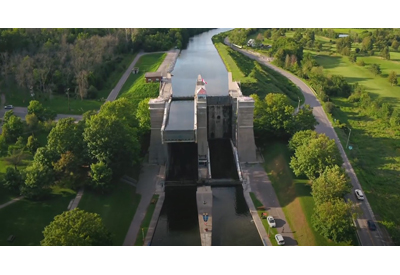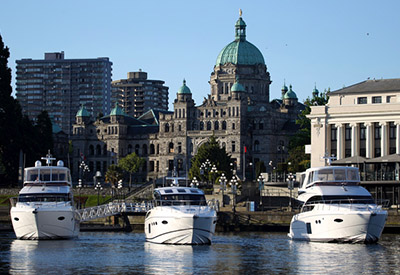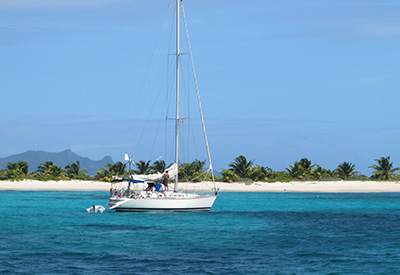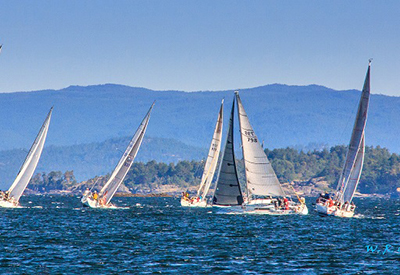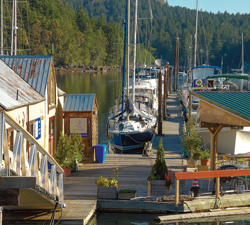Cruising the Leeward Station
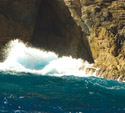
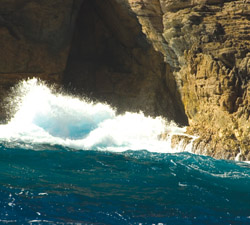 As the sun died in the western sky we strolled across a cobblestone parade ground, following its path like the faithful.
As the sun died in the western sky we strolled across a cobblestone parade ground, following its path like the faithful.
We watched it burn a pink and orange penumbra onto a harem of undulating mountains. We watched it etch deep shadows into east-facing slopes, silhouetting the palms that surmounted their heights.
We lounged four hundred feet above the Caribbean as we watched this light show displayed as if for our sole pleasure, even though we were hardly alone there at the top of Shirley Heights on Antigua’s south coast.
A steel drum band thoughtfully laid down a sound track for the spectacle, weaving music that seemed somehow appropriate here high above pewter seas burnished by the fleeing sun. The music emanating from beneath a cliff-top white awning reminded you of the sea – liquid melodies played out in the timbre of water.
The drums beat out a tattoo that seemed to fall like rain down into the bowl that was English Harbour – serenading a fleet of boats swinging at anchor there. The masts seemed to sway in time to the music. So did the cop standing on the steps of a stone blockhouse, bending and straightening his knees in time with the band.
But the sights and sounds were only a small part of this sensory delight.
Blue smoke arose from beneath another white awning, carrying an array of aromas that sent the taste buds into a frenzy. The smell of barbecued pork, of ribs, of chicken, of lobster, all conspired to instill a feeling that we were immersed in paradise.
There one those heights we had joined a fraternity of the sea. The couple dancing beside me both sported docksiders, the guy sipping a Wadadli beer next to the bandstand wore a Heineken Regatta T-shirt, a leather-skinned lady waiting in line for lobster boasted a Tilley hat.
We have been cruising the Leeward Station, even if we’ve made landfall tonight to soak up the pleasures of the jump-up held every Sunday at Shirley Heights.
The waters off the Leeward Station are demanding. They assail monstrous razor-sharp cliffs, leaving pictures in your brain of the perfect fluidity of pounding white lines of surf as they broke over reefs.
They are waters we explore on “Mana”, an Oceanis 423 chartered from Sunsail Yacht Charters at Nelson’s Dockyard, where, if you closed your eyes, you could imagine hobnobbing with the likes of Russell Crowe in costume, a place that was a set-piece for “Master and Commander.”
Looking down into English Harbour in the sudden night, we could just discern the outline of our boat as she awaited us and tomorrow with equal anticipation.
Even though tonight we seaworthy folk mingled with the more lubberly, today we’d plied the waters of the Leeward station. And would do so again come sunrise.
Today ended with a surfeit of sensual delights. So it began.
Sun was mixed with clouds that morning. Cottonball cumulus scurried across the sky, nervous as graduates at commencement. Wind roared down the jagged slopes in the lee of the fortress at Shirley Heights. Halyards clanged against masts. Casuarina trees danced and glittered like spangle-sporting debutantes.
The forecast was for six to ten foot waves and twenty-three knots on open water.
We raised sail inside the harbour, gliding past a stone dock where upended black cannon served as bollards.
We cleared the opening and soared and swooped like a bird of prey as white meringue waves marched across royal blue waters, hissing against the hull, whispering of the delights that awaited us as we unfurled the jib, as we hardened the main, as we romped over the water for points east.
It was not a day for maximizing sail trim, though our trim was seaworthy. It was not a day for scanning the knot meter, though our speed over ground was a healthy five or six knots. It was not a day for making passage but a day for finding out the meaning of boating.
Once clear of the harbour I found the waves at first unnerving but this was not Ontario sailing. No chop.
And the boat rode them like a sedan on like a Sunday afternoon drive, for these waters were not cruel so much as undulating. And the scenery was beautiful and painful as a glittering shard of glass.
We made for points east past great cliffs of sandstone, striated and carved by sea and wind. It was as if a tormented sculptor had taken his tools to this land. We passed razor-sharp headlands so hellishly beautiful, so stark they made you wonder if the creator had set himself the task of making extreme beauty out of ugliness – a sort of Zen dichotomy.
The Pillars of Hercules were nothing short of astounding but they were dwarfed by great crevasses in the rock, caverns etched by seas – and every once in a while a lonely sand beach – uninhabited and beautiful. “They say there is a beach a day on island,” said Neville Holloway, our skipper, with a grin.
“Pretty nice beaches too,” he added. It struck me that he was a master of understatement. Antigua boasts a year of beaches.
Cruise here for a few miles and you are inspired to stop. Drop the hook, dive of the transom. Laze on the foredeck for a while. And adjust your biological clock to island time.
We passed one particularly desolate but beautiful outcropping of rock and bore off the wind for points north after rounding Antigua’s southeast tip.
Before us lay a great humpbacked green island, sultry and voluptuous as a Rubens painting. A cliff towered four hundred feet over or port beam, lashed by the seas that glistened on these rock faces likes the glaze on a sugar donut. A reef lurked off our starboard beam.
And as we headed up to furl the foresail and drop the main I realized that we’d made the right decision in going with Sunsail’s skippered option – and Neville Holloway was the quintessential guide and skipper. He knew these waters intimately. He knew the best snorkeling, the best beaches, the best places to drop the hook.
Today we tucked into bays guarded by treacherous reef sentinels, places I would never have ventured into by myself. And my wife lazed on the foredeck and our son Adam took the helm, a wide grin pasted on his face. “How do you ever come back to Canada when you you’ve experienced this?” he asked from beneath the shadow of the Bimini.
And now we dropped the hook at one of Holloway’s favourite spots, in Nonsuch Bay, where we watched the might of the Atlantic battering a reef from somewhere in Africa. We swung in a lagoon as smooth as glass, bordered by an island decorated by a stretch of alabaster sand. A man and a woman walked hand-in-hand, dipping their feet every once in a while into neon lime and turquoise waters so beautiful I wondered idly if I could bottle them and bring them home.
Later that day we tucked into a hurricane hole at Indian Creek. We dropped the hook in flat waters sheltered by a sea-etched hill capped by a sprawling sand-coloured mansion with cedar shingle roofs. The mansion belonged to Eric Clapton.
As we dinghied into a stand of mangrove, encompassed in a green cavern, accompanied by the gentle throb of the engine, the barking of an errant dog somewhere on shore, I decided that Clapton had pretty good taste in real estate.
On another day we snorkeled amidst a stand of coral festooned with a fleet of neon fish, all the colours of the rainbow. It struck me simultaneously that this was an underwater show worthy of Las Vegas and that those houses we’d passed on shore, nestled at the edges of secret beaches, perched high above the waters, were inspired by this underwater palette – for they were painted the colours of the fish and the colours of the seas.
And even as we made for points west after lunch in a bay so beautiful I decided that this was where they’d spread my ashes when my time came, we rode the waves off our stern with the sensibility of a jazz musician. Adam, at the helm, responded to the following waves like a sax player blowing variations on a piano riff, Holloway gently guiding him through the process. Adam’s confidence grew along with his smile.
We sailed before the wind and we chatted with Holloway, a gentle Brit ex-pat who had been on-island for seven years and had no intention of going anywhere else. “The Antiguans are the salt of the earth,” he said. “You might have to prove yourself to them at first but then they will do absolutely anything for you.” He paused and gestured toward the expanse of royal blue water. “And there is no better sailing than this, is there?”
Early on the morning of our first day here Lily Cho and I had lounged in twin wooden Adirondack chairs on the roofed porch of the Sunsail base in Nelson’s Dockyard. We sipped coffee and devised a tentative float plan.
Cho, a Canadian who grew up in Montreal and runs Sunsail’s Antigua operations along with Sylvain Caburet, opened the copy of Doyle in her lap and spread out a nautical chart on the table before her. She nodded toward the chart and tapped Doyle with her index finger. “Doyle says there are more anchorages on Antigua than any other island in the Leewards.” Then a wistful faraway look crossed her face. “And so many of them are just so beautiful.”
I thought back to our first Antiguan charter, to the passage to Barbuda where we’d discovered a seventeen-mile pink beach that we shared with none but one catamaran bobbing gently in the swell. I remembered the waters of North Sound, populated with a multitude of anchorages and enough water for great tacks east in flat water protected by a massive reef to the north. I remembered an afternoon swimming off the transom as we swung at anchor off Ffrye’s Beach, a lonely ribbon of white sand guarded by a lone ancient sugar mill, a procession of green and blue mountains serving as backdrop.
And I remembered succumbing to the myriad charms of Nelson’s Dockyard, where two guys carried an orange and green spinnaker past a stone loft two hundred years old early on that first morning, past a whitewashed building with a cedar-shingled roof that once housed the officers of Nelsons navy.
For this was the Leeward Station.
Halfway down the Leeward chain, Antigua was situated at the crossroads of the seventeenth century sailing routes. Though only fourteen miles long and eleven miles wide the island was a key strategic strongpoint.
Its location and the wealth of harbours dotting the coast prompted Lord Nelson to come in 1784 to establish the headquarters of the Leeward fleet of the British Navy. But the nautical legacy began long before that: the first European ship to enter English Harbour was the “Dover Castle”, on a charter for “chasing ye pirates.”
The pirates may be gone, but not the boaters. Antigua is home to Nicholson’s, one of the first yacht brokers in the Caribbean; it is home to Falmouth, where mega yachts share the waters with rust buckets – and crew banks are tacked to every bulletin board from Falmouth to English Harbour; it is home to the Antigua Classic Regatta and Sailing Week and “after work” Thursday races, open to anyone with a yen for racing and a seaworthy vessel.
Early in the morning of our last day at English Harbour Adam and I dinghied over to Fort Berkeley and tied up to a barnacle-encrusted spar sticking out of the water.
A few crabs scurried for shelter as we lashed our line to the spar and pulled the boat up on the rocks. Then we stepped out onto the bottom flat of a stone stairway that rose up past coral rock bounded by Turk’s-head cactus, decorated by the occasional white flowering shrub. Directly above us was a round-roofed building of great stone blocks, two hundred years old.
We climbed this staircase and stared up at a mountain to our west, a green hump-backed monstrosity inhabited by grazing white goats and even more cactus – five or six different species, some twenty-feet high.
We marched along a path that followed weather-beaten ramparts crouching fifty feet above a concatenation of rocks. We looked down into cerulean seas and white crashing waves that attacked the shore like the once-anticipated amphibious attack of French forces from nearby Guadeloupe.
We strolled further east, past the powder magazine, now deserted.
We gazed across the narrow channel opening toward a little beach guarded by rock sentinels, a beach nestled in the lee of Shirley Heights. We raised our eyes to a towering hill in the east, noting an impregnable blockhouse squatting at the very top.
And then we gazed out to sea again. It was roiling and uneasy, though more like a great beast disturbed in sleep than a marauding predator.
Leaning there atop a parapet, its hewn stone blocks rough on our elbows, we were full of good feelings.

